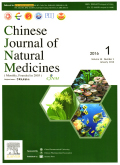Berbamine ameliorates ethanol-induced liver injury by inhibition of hepatic inflammation in mice
基本信息来源于合作网站,原文需代理用户跳转至来源网站获取
摘要:
Alcoholic liver disease (ALD) has become one of the leading causes of death in the world.Berbamine (BM),a natural product mainly derived from Berberis vulgaris L,possesses multiple bioactivities as a traditional medicine.However,the protective effect of BM on ALD remains unknown.In this study,we investigated the effect of BM on ethanol-induced hepatic injury in mice and its underlying mechanism.It was shown that BM at 0.3125-40 μmol·L-1 had no effect on macrophages and hepatocytes proliferation.BM at 5-20 μmol·L-1 significantly inhibited lipopolysaccharide (LPS) or acetate-induced IL-1β and IL-6 mRNA expression in RAW264.7 cells.Moreover,BM treatment significantly inhibited LPS-induced p65 and STAT3 phosphorylation in RAW264.7 cells.Hepatic histopathology analysis showed that inflammatory cells infiltration and lipid accumulation were suppressed by 25 and 50 mg.kg-1 BM administration in ethanol-induced hepatic injury mouse model.Meanwhile,BM treatment significantly inhibited serum ALT and AST levels in ethanol-fed mice.Oil red O staining results showed that BM administration ameliorated hepatic lipid accumulation in ethanolfed mice.Preventions of ethanol-induced hepatic injury by BM were reflected by markedly decreased serum and hepatic triglyceride (TG) and total cholesterol (TC) contents.Real-time PCR results showed that BM treatment significantly inhibited pro-inflammatory cytokines mRNA expression in ethanol-fed mouse liver.Remarkably,the mechanism of action of BM was related to the reduction of ethanol-induced NF-κB and STAT3 phosphorylation levels in liver.In addition,BM treatment significantly inhibited ERK phosphorylation but not JNK and p38 of MAPK pathway.Taken together,our results demonstrate a beneficial effect of BM on ethanol-induced liver injury via a mechanism associated with inactivation of NF-κB,STAT3 and ERK pathway,which gives insight into the further evaluation of the therapeutic potential of BM for ALD.

推荐文章
期刊_丙丁烷TDLAS测量系统的吸收峰自动检测
带间级联激光器
调谐半导体激光吸收光谱
雾剂检漏 中红外吸收峰 洛伦兹光谱线型
不同盐度、温度及光照对漂浮浒苔生理生态的影响
浒苔
盐度
温度
光照
生理生态
期刊_联合空间信息的改进低秩稀疏矩阵分解的高光谱异常目标检测
高光谱图像
异常目标检测 低秩稀疏矩阵分解 稀疏矩阵 残差矩阵
内容分析
关键词云
关键词热度
相关文献总数
(/次)
(/年)
引文网络
引文网络
二级参考文献 (0)
共引文献 (0)
参考文献 (28)
节点文献
引证文献 (0)
同被引文献 (0)
二级引证文献 (0)
2002(1)
- 参考文献(1)
- 二级参考文献(0)
2007(1)
- 参考文献(1)
- 二级参考文献(0)
2008(1)
- 参考文献(1)
- 二级参考文献(0)
2009(3)
- 参考文献(3)
- 二级参考文献(0)
2010(3)
- 参考文献(3)
- 二级参考文献(0)
2011(1)
- 参考文献(1)
- 二级参考文献(0)
2013(1)
- 参考文献(1)
- 二级参考文献(0)
2014(2)
- 参考文献(2)
- 二级参考文献(0)
2015(4)
- 参考文献(4)
- 二级参考文献(0)
2016(3)
- 参考文献(3)
- 二级参考文献(0)
2017(4)
- 参考文献(4)
- 二级参考文献(0)
2018(3)
- 参考文献(3)
- 二级参考文献(0)
2019(1)
- 参考文献(1)
- 二级参考文献(0)
2020(0)
- 参考文献(0)
- 二级参考文献(0)
- 引证文献(0)
- 二级引证文献(0)
引文网络交叉学科
相关学者/机构
期刊影响力
中国天然药物
主办单位:
中国药科大学
中国药学会
出版周期:
双月刊
ISSN:
2095-6975
CN:
32-1845/R
开本:
出版地:
南京童家巷24号
邮发代号:
创刊时间:
语种:
eng
出版文献量(篇)
1985
总下载数(次)
4
总被引数(次)
21556
期刊文献
相关文献
推荐文献
- 期刊分类
- 期刊(年)
- 期刊(期)
- 期刊推荐
中国天然药物2022
中国天然药物2021
中国天然药物2020
中国天然药物2019
中国天然药物2018
中国天然药物2017
中国天然药物2016
中国天然药物2015
中国天然药物2014
中国天然药物2013
中国天然药物2012
中国天然药物2011
中国天然药物2010
中国天然药物2009
中国天然药物2008
中国天然药物2007
中国天然药物2006
中国天然药物2005
中国天然药物2004
中国天然药物2003
中国天然药物2020年第9期
中国天然药物2020年第8期
中国天然药物2020年第7期
中国天然药物2020年第6期
中国天然药物2020年第5期
中国天然药物2020年第4期
中国天然药物2020年第3期
中国天然药物2020年第2期
中国天然药物2020年第12期
中国天然药物2020年第11期
中国天然药物2020年第10期
中国天然药物2020年第1期

 免费查重
免费查重










